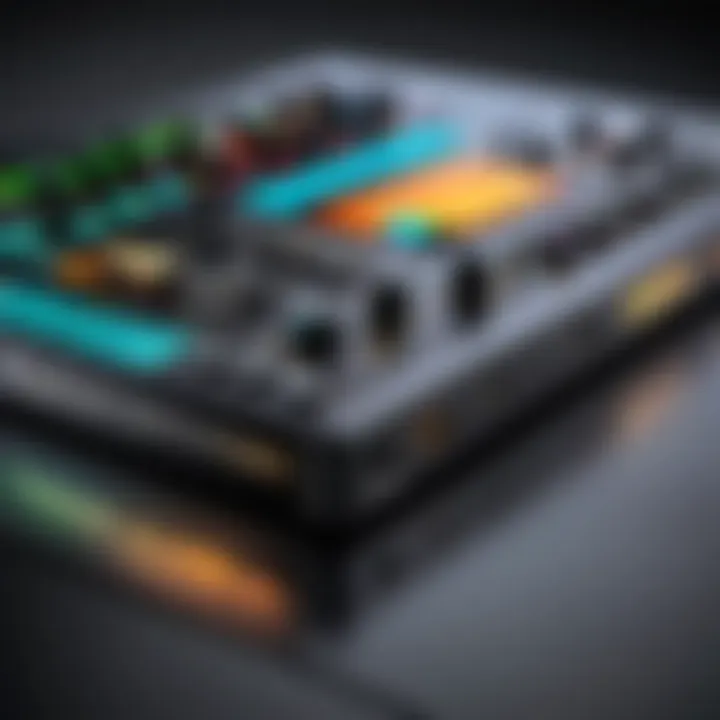Exploring the Landscape of Audio Effects Software


Intro
Understanding this realm requires an appreciation of both the technical aspects and practical applications. Each software package can bring its own unique flair to audio production. Thus, discerning the best tools available is essential for enhancing audio quality and creativity.
Product Overview
Audio effects software can be categorized into various types based on their functionality. Each type brings unique tools and methods to the table. Here is a brief overview of some prominent categories:
- Reverb and Delay: These effects simulate space and time, allowing soundscapes to breathe.
- Equalization (EQ): EQ is vital for adjusting bass, midrange, and treble frequencies in a mix.
- Compression: This effect evens out audio levels, essential for both live performances and recordings.
- Distortion and Overdrive: Used largely in electric guitar tracks, these effects add richness and character.
- Modulation Effects: This category includes effects like flanging and phasing that create movement and depth.
Key Features
When selecting audio effects software, IT professionals should consider several key features that greatly impact usability and performance:
- User Interface: A clean and intuitive interface ensures that users can navigate efficiently. Complex functions should be quick to access and understand.
- Compatibility: Ensuring compatibility with various digital audio workstations (DAWs) like Ableton Live, Pro Tools, or Logic Pro is fundamental.
- Preset Options: Many producers appreciate having presets available to save time and simplify their workflow.
- Automation: The ability to automate parameters enables dynamic changes throughout a track.
- High-Quality Algorithms: Software that uses advanced algorithms will provide superior audio processing capabilities.
Technical Specifications
The technical specifications of audio effects software can vary significantly based on the design and intended use. Key aspects include:
- Sample Rate: Higher sample rates generally allow for more detail in audio.
- Buffer Size: Affects latency; larger buffers may introduce delays, so finding the optimal size is essential for live performance.
- Bit Depth: Higher bit depth contributes to better dynamic range and fidelity.
Understanding these specifications equips audio professionals with the necessary knowledge to select software suited for their projects.
Performance Analysis
In evaluating audio effects software, performance is critical. This involves analyzing how well the software performs under both standard testing conditions and real-world usage.
Benchmark Test Results
Conducting benchmark tests can reveal how software handles audio processing tasks. Metrics such as CPU usage, latency, and memory consumption provide insight into the efficiency of the software. Examples of tests include:
- CPU Load: Tracking the load on the processor during usage reveals how intensive the software is.
- Latency Measurements: Testing for delays during playback can uncover usability issues in real-time applications.
These results help in understanding which software maintains quality no matter the task.
Real-World Usage Scenarios
When discussing real-world applications, it is essential to showcase how audio effects software integrates into different environments:
- Studio Recording: Here, versatility and high quality are paramount. Software with extensive libraries of effects can be advantageous.
- Live Sound Engineering: Fast response times and reliability are more critical, making specific tools stand out in live settings.
- Post-Production Audio: In film or gaming, detailed manipulation of audio is required, necessitating robust effects software with advanced creative options.
Intro to Audio Effects Software
The domain of audio effects software stands as a pivotal element in the audio production and sound design fields. This software is not merely an accessory; rather, it shapes the essence of audio creation today. A comprehensive understanding of audio effects software can enhance audio quality, provide creative possibilities, and help produce exceptional sonic experiences. This article delves into various aspects that make audio effects software essential for modern audio production.
Definition and Purpose
Audio effects software refers to digital applications that manipulate sound to achieve desired auditory experiences. The primary aim of such software is to enrich sound through various effects like reverberation, delay, modulation, and filtering. These tools serve numerous purposes, such as enhancing the emotional impact of a track or simply correcting audio imperfections during the mixing process.
Using audio effects, professionals can bring their creativity to life. For instance, dynamic effects like compressors and equalizers modify the audio signal's dynamic range and tonal balance, making them crucial in music production. Similarly, time-based effects like delays and reverbs recreate the illusion of space and depth, enabling producers to craft immersive listening experiences.
The functionality of audio effects software extends beyond simple enhancements. It offers sound designers precise control over audio manipulation, allowing for intricate soundscapes and textures. This control is invaluable in genres like electronic and cinematic music, where the sound plays a critical role in conveying the intended atmosphere.
Moreover, audio effects software integrates seamlessly with digital audio workstations (DAWs), making it a core component of contemporary audio production environments. Compatibility with various DAWs ensures versatility and accessibility for different users, from aspiring musicians to seasoned sound engineers.
In summary, audio effects software is not just a tool but a vital component in the audio production landscape. Its definition encapsulates a broad range of functionalities, each serving a specific purpose that enriches sound and enhances the overall auditory experience.
Types of Audio Effects
Understanding the various types of audio effects is crucial in the context of audio effects software. Each category plays a distinct role in shaping sound, influencing both the creative process and the final output. By comprehending the capabilities and applications of these effects, users can utilize them to enhance their audio production, addressing specific needs in different contexts.
Dynamic Effects
Dynamic effects are essential for controlling the volume levels of audio signals. These effects include compression, expansion, limiting, and gating. Compression reduces the dynamic range of a signal, ensuring that louder sounds do not overpower softer ones. This is particularly valuable in mixing, as it helps maintain a balanced sound.
"Dynamic effects can make the difference between a muddled sound and a polished mix." This type of effect ensures that individual tracks blend well. Expansion works oppositely by increasing dynamic range, allowing for more pronounced soft sounds. Limiting prevents audio signals from exceeding a specified loudness, which is crucial for mastering. Gating removes quiet sounds, reducing background noise during quieter passages.
Time-Based Effects
Time-based effects manipulate the timing of an audio signal, creating depth and space in a mix. Common time-based effects include reverb and delay. Reverb simulates how sound interacts with surfaces in an environment, adding realism to audio tracks. It can create a sense of space, from small rooms to vast halls.
Delay, on the other hand, involves echoing sounds at set intervals, enhancing the audio's texture. These effects are used creatively to give tracks a sense of movement and wideness. Musicians and producers use them to create ambient soundscapes or to make particular elements stand out in a mix.
Modulation Effects
Modulation effects vary certain aspects of a signal over time. They include chorus, flanger, and phaser effects. By duplicating the signal and altering its pitch or timing, these effects create a richer sound.


Chorus thickens the sound by layering multiple signals slightly out of tune with each other. Flanger combines this with a time delay that varies, producing a sweeping sound. Phaser modulates the phase of the signal, creating a distinct whooshing or swirling effect. These are often used in guitars and synthesizers to enhance sonic richness and complexity.
Distortion and Saturation Effects
Distortion and saturation effects add warmth and character to audio signals. Distortion is typically associated with overdriving an audio signal, creating a gritty, aggressive tone often used in electric guitars. It can transform sound, making it more dynamic and exciting.
Saturation, however, is a more subtle effect that emulates the warmth and compression of analog equipment. It can make audio signals feel fuller and more cohesive. Both types of effects are valuable in creating a unique sound and are heavily used in various music genres.
In summary, the diverse types of audio effects each offer distinct features that cater to different sonic needs. By grasping these concepts, users can effectively enhance their audio productions, utilizing the right tools and techniques for specific goals.
Key Features of Audio Effects Software
In the realm of audio production, the efficacy of audio effects software is heavily determined by its core features. Understanding these features is essential for IT professionals and tech enthusiasts alike. The capability to manipulate sound with precision hinges on the design and functionality of the software in question. From user interface to processing capabilities, each aspect plays a significant role in audio production efficiency and flexibility.
User Interface Design
The user interface (UI) of audio effects software is not just a cosmetic element; it is crucial for workflow efficiency. A well-designed UI can streamline the creative process. Clarity and accessibility can mean the difference between intuitive usage and frustration.
Software such as Pro Tools and Logic Pro X exemplify effective UI design by providing intuitive layouts. These programs organize controls logically, allowing users to navigate easily. This minimizes the time spent searching for features, facilitating a more focused approach to audio manipulation.
Furthermore, customizable interfaces allow users to tailor their workspace according to individual needs. This personalization can enhance productivity, enabling a more satisfying user experience. Therefore, evaluating UI design is imperative for anyone seeking to optimize their audio production.
Signal Processing Capabilities
Signal processing is at the heart of audio effects software. This encompasses various operations that manipulate sound signals to achieve desired outcomes. The effectiveness of these operations fundamentally shapes the audio quality.
Professional-grade software like Ableton Live and FL Studio boast advanced signal processing capabilities. These range from basic alterations like equalization and compression to sophisticated functions such as dynamic range manipulation and sound synthesis. The ability to handle multiple audio sources simultaneously is a notable advantage. It allows for intricate layering of audio tracks, enriching the final production.
In addition, high-quality algorithms ensure that the audio integrity is maintained, even when heavy processing is applied. This is vital for ensuring the sound remains clear and professional, regardless of how many effects are layered.
Compatibility with DAWs
The compatibility of audio effects software with Digital Audio Workstations (DAWs) holds substantial importance. DAWs form the backbone of audio production, and seamless integration with these platforms is a necessity.
Software such as FL Studio, Pro Tools, and Logic Pro X are built to work compatibly with a variety of DAWs. This ensures that users can employ their favorite effects without encountering compatibility issues. The integration often extends to using virtual instruments as well, allowing for a comprehensive audio production environment.
Additionally, this compatibility promotes a more collaborative workflow between different software tools. Users can share projects across various platforms with ease. Thus, understanding how well a piece of audio effects software integrates with existing DAWs is crucial for any audio professional.
Evaluating the key features of audio effects software thus provides insights into its suitability for specific production needs. In a landscape replete with options, a meticulous analysis will guide users to software that enhances their audio projects more effectively.
Integration in Digital Audio Workstations
Integration in Digital Audio Workstations (DAWs) plays a crucial role in the functionality and versatility of audio effects software. DAWs serve as the central hub for audio production, allowing users to compose, record, edit, and mix music or sounds. Audio effects software enhances these capabilities by providing a variety of tools to manipulate sound, making integration a necessity for optimal workflow and creativity.
One of the primary benefits of integrating audio effects software within DAWs is the seamless process of applying effects in real-time. This means that users can hear the changes as they make them, which is essential for fine-tuning specific elements in a production. Real-time processing can significantly improve creative flow, reducing the need for repeated back-and-forth between listening and adjusting settings.
Furthermore, integration facilitates various audio routing techniques. This allows for intricate setups where audio tracks can be sent through multiple effects chains, giving the user more control over the sound. Advanced audio routing opens up a realm of possibilities for creating distinct soundscapes and textures. Users can customize how signals are processed and manage complex arrangements that involve multiple audio sources and effects.
Considerations regarding integration include compatibility between different software and hardware systems. Ensuring that the audio effects software works smoothly with the selected DAW is vital. Any discrepancies in compatibility can result in latency issues or crashes, disrupting the creative process. Additionally, understanding the signal flow within the DAW can help users better manage how effects are implemented.
"A well-integrated audio effect setup can unlock new creative avenues in music production."
In summary, the integration of audio effects software in DAWs is fundamental to modern audio production. It not only enhances user experience but also amplifies creative potential through real-time processing and advanced routing. Without effective integration, the vast capabilities of audio effects software may remain underutilized, limiting the possibilities for professionals in the field.
Audio Routing Techniques
Audio routing is a vital aspect of integrating audio effects software into DAWs. It involves directing audio signals to different pathways or channels, applying effects in various sequences to create complex sound textures. Here are some important audio routing techniques:
- Bus Routing: This method allows users to send multiple audio tracks to a single bus channel. The bus can then be processed with uniform effects, which helps maintain consistency across the mix.
- Parallel Processing: This technique involves duplicating an audio track and applying different effects on one of the copies. The two tracks are then blended together, giving more depth and richness to the sound.
- Serial Processing: In this setup, audio signals pass through effects in a sequence. This method is useful for crafting a specific sound by applying effects directly in the order they are intended to be heard.
- Send/Return Configuration: This allows users to send a portion of the audio signal to an effects unit while keeping the original signal intact. This method is particularly useful for reverb or delay effects, which can dominate the mix if applied fully.
Understanding these techniques contributes significantly to effective sound design and mixing in audio production. They empower users to explore various creative possibilities and lay the foundation for innovative sounds.
Performance Benchmarks
In the realm of audio effects software, performance benchmarks serve as essential indicators. They help evaluate the efficiency and effectiveness of different software options. A benchmark can assess various elements like processing speed, resource consumption, and overall stability. For sound engineers and producers, understanding these benchmarks is crucial. It assists them in selecting the right software that meets the demands of modern audio production.
Latency Considerations
Latency is a critical factor when discussing performance benchmarks. It refers to the delay between the input of sound and its output through the software. High latency can negatively impact real-time audio production, making it difficult to perform tasks like live recordings or mixing. Lower latency ensures that audio effects process in near real-time, enhancing the user's experience and workflow. To address latency, many software developers implement features like direct monitoring and optimized processing algorithms. Evaluating these latency specifications helps users make informed decisions about which tools to integrate into their digital audio workstations.
Resource Efficiency
Resource efficiency measures how well audio effects software utilizes system resources. This includes CPU usage, memory consumption, and GPU requirements. Efficient software will perform tasks using minimal resources while maintaining high-quality output. For IT professionals and tech enthusiasts, assessing resource efficiency is vital. It ensures seamless operation without overloading the computer, especially during complex projects featuring multiple tracks and effects. Software that demands fewer resources allows users to run multiple applications simultaneously, which is vital in collaborative environments.
In summary, performance benchmarks focus on latency and resource efficiency. Understanding these elements can significantly improve audio production workflows, making it easier to choose the right tools for specific tasks.
Real-time vs. Offline Processing


In the world of audio effects software, understanding the distinction between real-time and offline processing is crucial. Each method has implications on both workflow and final output, impacting audio production in various ways.
Real-time processing refers to applying effects during playback. It allows audio engineers to hear changes instantly. This scenario is essential in live environments, where performers need immediate feedback. The main advantage lies in the ability to experiment freely. Producers can tweak settings on the fly, preserving the spontaneity of creativity. However, this approach requires significant processing power and low latency to maintain audio quality.
On the other hand, offline processing applies effects after audio recording has taken place. This method provides a level of control and precision that is often desired in mixing and mastering stages. Engineers can apply complex effects chains without the constraints of processing power affecting real-time listening. The processing occurs in a way that is independent of playback, which can lead to higher quality results in some cases, but it lacks the immediacy that many creative situations require.
Use Cases
The choice between real-time and offline processing depends on the project context.
- Live Performances: For live concerts, real-time processing is essential. Musicians use tools like Ableton Live to apply effects while playing.
- Recording Sessions: In the studio, offline processing often takes precedence. Producing a polished track may involve layering effects in a precise manner using software like Pro Tools or Logic Pro X.
- Sound Design: Many sound designers prefer offline processing when crafting unique sounds. They can use tools like FL Studio to apply multiple effects in a non-linear fashion.
Performance Implications
Choosing the wrong processing method can lead to performance issues. Real-time processing increases the demand for CPU resources. If the software cannot handle the load, it results in latency or audio dropouts, affecting the recording or performance. Conversely, offline processing might allow more elaborate effects but can consume considerable storage and time during rendering.
When utilizing real-time processing, engineers should:
- Monitor CPU usage closely
- Optimize the DAW settings for performance
- Use efficient effects to reduce strain
For offline processing, keep in mind:
- File sizes may increase due to complex effects
- Longer rendering time may disrupt workflows
In summary, real-time and offline processing serve distinct purposes in audio production. Understanding their use cases and implications allows professionals to make informed choices. Both methods hold value and can be optimized based on specific needs in the creative process.
"Choosing the right processing method can define the success of an audio project, balancing immediacy with precision."
Recent Trends in Audio Effects Software
The field of audio effects software is constantly evolving. Keeping pace with the rapid advancements in technology is crucial for audio professionals. Knowledge about recent trends helps experts stay informed and competitive. It allows them to leverage new tools that can enhance their workflows. Understanding these trends also reveals how software is shaping the future of audio production.
AI and Machine Learning Integrations
AI and machine learning are becoming increasingly significant in audio effects software. These technologies provide powerful capabilities that can transform audio production processes.
- Predictive Modelling: Machine learning can analyze audio patterns. This leads to smarter audio effects implementations. Algorithms can predict how adjustments will alter the sound, offering tailored suggestions to users.
- Automated Mixing: Integrating AI can automate routine tasks. This allows professionals to focus on creative aspects. For example, AI tools can balance levels, optimize EQ settings, or suggest effects based on genre.
- Content Generation: Some software now incorporates AI that generates soundscapes or effects. This feature assists sound designers in creating unique audio elements without extensive manual input.
Adopting these technologies improves user experience significantly. The result is more efficient workflows and enhanced sound quality with less effort.
Cloud-Based Solutions
- File Storage: Audio projects can be stored in the cloud. This makes it easy to access anywhere, ideal for remote work.
- Collaboration Features: Multiple users can work on audio projects simultaneously. This streamlines input from different stakeholders, providing a platform for real-time feedback.
- Subscription Models: Many cloud-based solutions operate on a subscription basis. This model removes barriers to entry, allowing smaller studios to access high-end software at a lower cost.
The shift to cloud-based systems is more than convenient. It offers scalability and flexibility. As needs change, users can easily select features that fit their current projects without the need for extensive software purchases.
The integration of AI and cloud computing reflects the industry's shift towards more adaptive and resource-efficient audio production techniques.
Popular Audio Effects Software
The selection of audio effects software influences workflow, creativity, and the overall production process. This section will discuss several leading titles, focusing on their unique characteristics and benefits. The right software can make a substantial impact on the final audio output, so it's essential to explore these options thoroughly.
Pro Tools
Pro Tools stands out as an industry-standard audio workstation, widely recognized for its robust performance and extensive features. This software is favored in professional studios and used by audio engineers across the globe. Pro Tools excels in handling complex sessions with many tracks and its powerful editing capabilities.
Key features include:
- High Track Count: Users can work with large numbers of audio tracks simultaneously.
- Comprehensive Editing Tools: Offers precise and efficient editing functionalities.
- Industry Integration: Seamlessly integrates with a variety of hardware and other software.
Additionally, Pro Tools supports advanced features such as surround sound mixing and extensive plugin options, which allow sound professionals to tailor their setups according to their production needs.
Ableton Live
Ableton Live is recognized for its versatility and intuitive interface. It serves both as a Digital Audio Workstation and a performance tool, making it a favorite among electronic music producers and live performers. Its session view enables spontaneous composition and experimentation without strictly adhering to a traditional timeline.
Noteworthy elements include:
- Real-Time Audio Manipulation: Allows users to manipulate audio clips on the fly.
- Wide Selection of Instruments: Comes with a range of built-in instruments and effects to enhance sound design.
- MIDI Support: Comprehensive MIDI capabilities provide extensive control over virtual instruments.
Ableton Live's ability to support creative workflows makes it a powerful ally for anyone looking to innovate in music production.
Logic Pro
Logic Pro X is a music production software that has gained popularity due to its user-friendly interface and professional-grade capabilities. It is specifically developed for macOS, allowing integration with Apple’s ecosystem. This software offers a vast range of plugins, instruments, and sound libraries, making it versatile for various music genres.
Prominent features include:


- Smart Tempo: Syncs audio tracks regardless of their original tempo.
- Flex Time and Pitch: Provides flexibility in timing and pitch correction.
- Comprehensive MIDI Editing: Includes advanced MIDI editing and performance features.
Logic Pro X is suitable for both beginners and seasoned professionals, catering to a wide audience in audio production.
FL Studio
FL Studio, previously known as FruityLoops, is a popular choice among beat makers and producers for its user-friendly design and powerful tools. It is particularly noted for its pattern-based workflow, which simplifies the creation of complex musical compositions.
Key highlights include:
- Piano Roll: An intuitive interface for creating and editing melodic patterns.
- Powerful Mixer and Effects: Offers a flexible mixer with an extensive range of effects.
- Lifetime Free Updates: Users receive updates for life, ensuring they always have the latest features.
FL Studio's approach to music production appeals especially to those who prefer a decentralized workflow, making it a staple in home studios.
"The right audio software can not only enhance creativity but also optimize the entire production workflow."
In the realm of audio effects software, staying updated on popular tools ensures that sound professionals can make informed decisions that align with their production goals.
User Evaluations and Feedback
User evaluations and feedback play a crucial role in understanding the effectiveness and usability of audio effects software. Feedback from users provides insights that can help developers enhance features, improve performance, and address any issues that might arise during actual usage. For IT professionals and tech enthusiasts, these evaluations offer a validation of products based on real-world experiences instead of mere marketing claims.
User feedback can also highlight unique features or hidden gems within audio effects software that may not be immediately apparent. Often, users discover workflows or applications that can be remarkably beneficial but are not well advertised. This information is valuable for developers seeking to refine their products according to the needs and expectations of their audience.
Furthermore, gathering evaluations creates a sense of community around audio effects software. Users often share their experiences in forums or review platforms, providing both constructive criticism and praise. This dialogue enhances the relationship between software companies and their customers, fostering loyalty and continuous improvement.
Key considerations when examining user evaluations include:
- Authenticity: Ensure feedback comes from credible sources to avoid bias.
- Diversity: Look for a range of opinions that reflect various use cases and skill levels.
- Trends: Identify recurring themes in feedback to pinpoint consistent strengths or weaknesses in the software.
- Engagement: Evaluate how effectively developers respond to feedback and incorporate it into updates.
In summary, user evaluations and feedback not only guide software development but also empower users by making their voices heard in the evolving landscape of audio effects software. This interaction is vital for both improving tools and enriching the collective knowledge base of the community.
Community Forums
Community forums serve as vibrant hubs for discussions surrounding audio effects software. They are platforms where users can ask questions, share advice, and post reviews. Such interactions foster knowledge exchange among beginners and seasoned professionals alike, contributing significantly to the improvement of audio production techniques.
In community forums, users often share:
- Tips and Tricks: Practical suggestions on how to use specific effects effectively.
- Problem Solving: Solutions for common issues faced during production, which can prevent time loss.
- Comparative Reviews: Experiences with different software solutions, helping peers make informed decisions.
Engaging in these forums can also uncover new plugins or updates that users may not discover through official channels. This allows for a more dynamic experience within the realm of audio effects software.
For anyone looking to enhance their audio production skills, participating in community forums is highly recommended. By doing so, one enters a shared space that promotes learning and collaboration with fellow audio enthusiasts.
Future of Audio Effects Software
The future of audio effects software is a critical topic within the broader context of audio production. As technology evolves, so too do the capabilities and applications of software that shape the audio landscape. Focusing on this topic reveals essential elements, potential benefits, and the underlying considerations necessary for both developers and users.
Emerging from the current trends are various emerging technologies that are likely to define how audio effects software operates in the years to come. With the rise of artificial intelligence and machine learning, tools that once required manual adjustments can now automatically adapt to the specifics of a sound environment. For example, AI-driven plugins can analyze audio tracks and suggest effects based on established patterns or preferences indicated from user data.
In addition, advancements in cloud technology are reshaping accessibility. Cloud-based solutions offer flexibility by allowing users to run complex processing without extensive local resources. This creates new workflows where collaboration across distances becomes seamless, and sharing effects or presets happens smoothly among teams.
"Audio effects software must not only keep up with technological advancements but also anticipate user needs that continue to evolve."
Emerging Technologies
As mentioned earlier, the integration of artificial intelligence in audio effects software represents a major shift. This development encompasses real-time learning from user interactions, leading to personalized audio effects solutions. AI can simplify tasks like mixing, mastering, and sound design, enabling producers to spend less time on technical details and more on creativity. Moreover, machine learning algorithms are now capable of improving the quality of sound processing. They enable more accurate and effective modifications, such as noise reduction or spectral editing, which were challenging to achieve before.
The role of real-time processing is also increasing, particularly as hardware capabilities improve. Emerging technologies are driving lower latency and higher fidelity in audio production, making it possible to implement complex effects during live performance.
Market Forecasts
Looking to the market forecasts, the audio effects software sector is anticipated to experience robust growth in the coming years. Predictions suggest an annual growth rate that echoes the rising demand for high-quality audio in diverse applications, from gaming to podcasting to music production. Industry reports from sources like Britannica indicate that factors such as increased consumer demand and the proliferation of audio-related content will continue to fuel this expansion.
Investments in innovative features and user-centered design will be pivotal for software developers. As users become more tech-savvy, there is a necessity to provide intuitive interfaces while maintaining powerful functionality. Additionally, historical data show that software that adapts quickly to user trends usually performs better in a competitive market.
In summary, the future of audio effects software harbors promising advancements driven by emerging technologies and favorable market dynamics. Developers and users alike must remain vigilant and proactive in navigating this landscape, ensuring they harness the full potential of these innovations.
Closure
In the exploration of audio effects software, we recognize its profound impact on modern audio production. This article has dissected key elements critical to both the functionality and the evolution of software used in various audio applications.
Importance of End
The conclusion highlights the intersection of technology and creativity. Audio effects software plays a vital role for sound engineers, producers, and musicians alike by transforming raw audio into polished tracks.
Moreover, understanding the latest trends, such as AI integrations and the shift towards cloud-based solutions, allows professionals to remain competitive in an ever-evolving landscape. As the market forecasts shift, staying informed helps in making strategic decisions for both current projects and future investments.
Benefits and Considerations
- Enhanced Creative Freedom: Users can explore diverse soundscapes and effects, enabling innovative compositions.
- Performance Optimization: Knowledge of software performance benchmarks enables users to utilize resources more effectively, ensuring quality production without sacrificing efficiency.
- Engagement with Community Feedback: Active involvement in forums fosters discussion and learning, allowing users to exchange techniques and tips for improving their skills.
The area of audio effects software is not just about functionality; it's about the creative possibilities it unlocks. Professionals who continue to evolve their understanding of these tools are likely to thrive in the industry.



